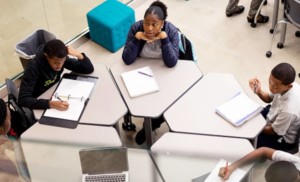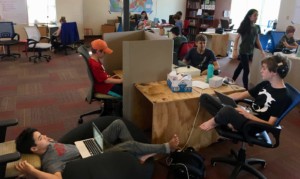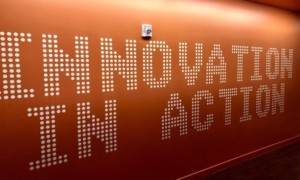What will be the ‘shipping container’ of Edu2.0?
Forty years ago the International Organization for Standardization (ISO) adopted a standard size container and it revolutionized shipping—investment in common infrastructure went up and the cost of goods shipped went down. Wal-Mart and globalization happened.
We need a digital content standard to launch the second generation of online learning. It will drive investment which will improve quality, adoption and ultimately achievement.
Today, most online content is flat and sequential—textbooks online with a few videos. In the adaptive future, smart recommendation engines will queue content based on learning level, style, and modality. This requires a body of content in standardized units with a common tagging scheme.
Wireless Generation’s Burst product sends out targeted lessons from FreeReading.net. It’s cool, like an automated SFA, but it’s one online basal. Proprietary products like Dreambox (a k-2 math product) have a pretty good adaptive engine but it runs against a limited number of the company’s learning activities. Some of the virtual providers are disaggregating and tagging their content to make it more adaptive, but they’re still proprietary and don’t allow mixing and matching—it will allow a partially adaptive slog through a single body of content.
The School of One pilot this summer required the NYC DOE team to 1) find folks willing to disaggregate content, and 2) tag it by level, theme, and learning mode, and 3) build a kluge recommendation engine to string learning objects together. It was a lot of work for a 6th grade math pilot and would require a huge investment for a comprehensive K-12 curriculum for a few dozen NYC schools to pilot.
Here’s what should happen next:
· Set standards: a consortium (like School of One, Achieve, iNACOL, COSN, and CCSSO) should set standards for digital content in chunks ranging from short objects and lessons to longer units and courses.
· Tagging scheme: Then they should develop a tagging scheme by theme, modality, and use license.
· Keep moving: in the mean time, School of One should keep chugging along and expanding their pilot with their own framework—we need more next gen examples fast!
· Issue RFP: Groups of districts, states, and networks should issue RFPs for content and producers (or intermediaries) would tag and submit their content. Some RFPs could be entirely open, others a mix of open and proprietary. Some RFPs would be at the learning object level, others may only ask for units and courses.
· Develop pay mechanism: It will eventually be possible to create a series of micro-transactions to pay producers based on use and learning gain.
· Fund service economy: A service economy of taggers, repositories, recommendation engines, assessment providers, next gen LMSs, social learning networks, PD and SES providers, and school improvement services would spring to life with venture. Philanthropic, and i3 support.
This is a lot more difficult than iTunes, but it’s time for an ascendant platform like that and it will only happen with a handful of influential folks set standards and folks that control access to markets to issue forward leaning requests for content. The process outlined above would break out of the flat boring choices we have today and usher in the next generation of engaging personalized content. Alex Kozak’s “open trajectory of learning” would be accelerated by a set of standards and an online economy where open and proprietary content could flourish together. Then everyone would have access to a real School of One.






Tom Sundstrom
I cound not agree more, but for one exception. The system needs to be knowledge/skills centric. That's the common denominator that can connect everything from standards to curriculum and assessments. And for measuring student progress, it's the natural unit of measure. We have designed and are building such a system. It is as you envisioned, full of 3rd party opportunities and fundementally, a customized learning system. We just published a web site describing how it works and why it's needed at www.sundryeducation.com.